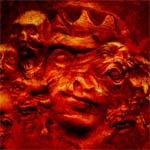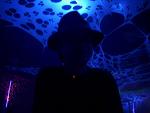| Author
|
Is there a logical way to figure out the key of a track after changing bpm on a CDJ?
|
kahn
IsraTrance Full Member

Started Topics :
99
Posts :
786
Posted : Oct 28, 2009 02:42:35
|
Hi! This might seem a bit off topic for this forum, but the production forum didn't fit, and neither did the DJ/Artist discussion. So I post it here in hopes that somebody knows the answer.
Some background information... I am a DJ and Producer. I have been a DJ for awhile now, despite that this might seem like a "noob" question to some. 
Normally when I mix tracks I never adjust more than ±2% on the tempo adjustment (this is for Pioneer CDJ's fyi). This in almost all cases preserves the original key of the track without the need for "master key" (the key lock feature) which makes sound quality degrade.
I know that obviously you can key music by ear, and that is what I have done in the past when I have needed to adjust a track further in any direction. But I was wondering if there was any fast/logical way to tell how much the key has changed with a given percentage adjustment.
In this example, I have a 140 BPM track in the key of C-Minor. If I want to pitch it up to 145 BPM (~3.5%) at approximately what key will the song be at?
        http://www.soundcloud.com/djKAHN http://www.soundcloud.com/djKAHN |

|
|
"42"
IsraTrance Full Member

Started Topics :
129
Posts :
516
Posted : Oct 28, 2009 03:45
|
|
Basilisk
IsraTrance Full Member

Started Topics :
168
Posts :
2984
Posted : Oct 28, 2009 04:05
|
I am no expert... however, my approach is to use key locking within ±2 and always raise the tempo to avoid algorithmic artifacts, most of which stem from synthesis (which happens when you pitch down), not removal (which happens when you pitch up). If the track playing is at 130 BPM and the incoming track is 128 then I pitch up ~1.5%. If the current track is 128 but I would like to mix into a 130 BPM song then I wait for a break then increase the speed on the track that is playing.
If you're interested in mixing across a wider BPM range I suggest you calibrate your equipment at home. It should be easy to hear the difference in quality under key locking at ± 8%. (Pitching up shouldn't sound nearly as bad as pitching down.) Just play around until you find the sweet spot for your gear where key locking starts to sound nasty.
Conceivably the quality of the key locking algorithm will differ depending on what equipment you use. I haven't done any sort of testing but I would imagine that the higher-end Pioneer decks have better processing than the entry-level models.
I haven't messed with any of that "colour" mixing or pitch locking. I figure that any additional processing is more likely to introduce unwanted side effects. Given the rich production value of most psytrance I generally advise minimizing pitch and tempo alterations wherever possible. Sometimes less is more. But that's just my opinion.
|

|
|
Axis Mundi
Axis Mundi

Started Topics :
75
Posts :
1848
Posted : Oct 28, 2009 04:14
|
140/145 = 3.44827%
12*3.44827% = 0.41379
Assuming that's anywhere close to correct (I'm not sure at all) the track would rise in pitch by less than half a semitone. Meaning it MIGHT go to C Major but I highly doubt it and I don't think anyone who doesn't have the "psytrance golden ear" will be able to tell.
Honestly though, pitch modulation is one of the most common modulations in psytrance, and snares/highhats are noise-based frequencies so the only place you'd be able to tell is the bass, which if it's in the key of C then chances are it will be too insignificant to make a difference.
Not only that, if you have a track in the key of C, and say the bassline is a flat progression of C notes, you can play a track in any other key that has a C note in it and it will be correct.
Or you can look at it this way.
Say you are looking at two tracks in Cubase, so in each channel you can see the track going from left to right representing its progression through time. Now look at them vertically as if one were stacked on the other. The bass notes of tracks A and B make a bass chord and as long as bass note A and bass note B are using scales that have the other note in its own scale then it will also be musically correct.
As long as the notes playing together at (x) moment in time have the other note in that scale, they can be in different keys and still be harmonious.
Or I could have gotten something wrong somewhere and I'm talking out my ass, and someone more knowledgeable than me in music theory will come along and tell us both what's up. |

|
|
Login
IsraTrance Full Member

Started Topics :
65
Posts :
1707
Posted : Oct 28, 2009 04:48
|
I dont know the rule but form rapid evolution site:
"When matching songs harmonically, you must be aware that changing the speed of a song also changes its key, unless a key controller is used. To be exact, a 5.94631% shift in speed will shift the key by a half-step. So if you're mixing a song in Cm at +6%, it's going to be in C#m/Ebm. Similarly, a change in RPM on your turntable from 33 to 45 will shift the key up 5 half-steps, from Cm to Fm."
        "The dedication to repetition — the search for nirvana in a single held tone or an endlessly cycling rhythm — is one of electronic music's noblest gestures." "The dedication to repetition — the search for nirvana in a single held tone or an endlessly cycling rhythm — is one of electronic music's noblest gestures." |

|
|
Axis Mundi
Axis Mundi

Started Topics :
75
Posts :
1848
Posted : Oct 28, 2009 04:55
|
The difference between key and scale is that the key is the note the scale is based on, and the scale depends on the notes that are around the key note.
So if Track A is in the key of C and uses a Phrygian scale, but the bassline consists of a string of C notes only, and Track B is in the key of G, it can be any scale you can think of and the basslines will always be harmonious. If Track B were in the key of G using the chromatic scale (meaning all 12 semitones are in the bassline in (x) pattern), it will also be harmonious. In the second Track B scenario (track B in Chromatic scale, key of G), Track A can now be any scale in the key of C and every bassnote will be harmonious when overlapping each other into a chord.
That's looking at it "vertically", i.e. Tracks A and B overlapping each other in a mix.
Where it gets tricky is when you start looking at it horizontally again. Again, the scale of the track is determined by the series of notes in the pattern, so if Track A in the key of C is using scale X and Track B is in the key of G using scale Y (X or Y being scales that use notes the other does not use) when one of those notes are played in comparison to the other scale (i.e. in a mix), it will sound off-key.
Fortunately most psy-trance basslines don't actually use that many notes in a pattern, so this is actually not so common of an issue. Also the mid-frequencies of many psytrance tracks contain pitch modulations through LFOs or whatever, so they are constantly traveling between semitones, and the higher frequencies (snares and hi-hats) are noise-based sounds (noise means an oscillation so drastic and rapid it crosses the highest and lowest frequencies at a speed most ears can't pick up on) so any off-key notes that occur happen at such a fraction of a second that they are barely noticeable by most listeners at best.
So in my opinion, mixing by key is really only very useful when playing the most melodic of melodic psytrance tunes.
The phenomenon of two pumping basslines, when mixed together seem to sound like a flat tire, is usually due to some kind of phase cancellation in the waveforms of the basslines (i.e. unique to those two tracks put together) and bumping one or the other by +5 bpm in the 140+ bpm range won't really solve the issue anyway.
That's the way I understand it; someone please feel free to correct me if I'm wrong.
|

|
|
mk47
Inactive User

Started Topics :
118
Posts :
4444
Posted : Oct 28, 2009 06:40
|
|
kahn
IsraTrance Full Member

Started Topics :
99
Posts :
786
Posted : Oct 28, 2009 07:16
|
What I am gathering from the replies so far is that a half tone is about 6% (thanks Login). That would mean that my 3.5% change would put it somewhere in the middle. It will more than likely mix it sounds like.
To clarify:
I am specifically trying to avoid using any key lock so as to retain the most fidelity I can.
I use mixed in key's 'Camelot Wheel' and it works really well to organize stuff in key.
        http://www.soundcloud.com/djKAHN http://www.soundcloud.com/djKAHN |

|
|
Dennis the menace
Moderator

Started Topics :
128
Posts :
2899
Posted : Oct 28, 2009 07:25
|
6% is the magic number, it will move your song to the adjacent key on the piano.
If your original song is in F Minor, increasing the tempo by 6% will move the song one key to the right to give you G-Flat Minor.
If you change the tempo by less than 3%, keep your original key. If you change the tempo by 3% or more, use the 6% key.
It works in this way because 3% is the middle point. Anything below 3% will be closer to your original key (F Minor) and anything above 3% will be closer to your 6% key (Gb minor or E minor, depending whether you increase or decrease the tempo).
|

|
|
Login
IsraTrance Full Member

Started Topics :
65
Posts :
1707
Posted : Oct 28, 2009 09:12
|
in psytrance a 6% would sound horrible anyway, it implieas about a 9 bpm change XD
        "The dedication to repetition — the search for nirvana in a single held tone or an endlessly cycling rhythm — is one of electronic music's noblest gestures." "The dedication to repetition — the search for nirvana in a single held tone or an endlessly cycling rhythm — is one of electronic music's noblest gestures." |

|
|
Dennis the menace
Moderator

Started Topics :
128
Posts :
2899
Posted : Oct 28, 2009 09:33
|
yea, 6% is overkill when it comes to pitching psytrance, but that's where the key changes..
But anything below 3% is fine when mixing and also when it comes to pitching 
|

|
|
TimeTraveller
IsraTrance Full Member

Started Topics :
80
Posts :
3207
Posted : Oct 28, 2009 13:01
|
when pitching "Trance Africa Express" from Sheyba all tempos are cool and special.I like the original but most likely when its pitched completely down on turntables - that is more tribal in this case to me..
And by pitching up it is also great when in good trance.Well I guess sometimes it is sth about the great production of a song and it goes on many tempos.That's my subjective opinion.And that is for sure another production like the most from nowadays.
A production where notes and harmony in composition is really a factor.Timeless psytrance classic.        https://soundcloud.com/shivagarden https://soundcloud.com/shivagarden |

|
|
almost_human KROX ( Phantasm Rec .)
IsraTrance Junior Member

Started Topics :
25
Posts :
2369
Posted : Oct 28, 2009 14:52
|
I have Tried & experienced that 6% is all Gud with no Fideling with the Notes & now people are so aware of psytrance that they can easily know that the Track is played on a higher Pitch .. 
        UVV Project / Mandala Project / Crystal noize Project / Cosmic Crew UVV Project / Mandala Project / Crystal noize Project / Cosmic Crew
Be not angry that you cannot make others as you wish them to be, since you cannot make yourself as you wish to be. |

|
|
Xolvexs
IsraTrance Senior Member

Started Topics :
241
Posts :
2848
Posted : Oct 28, 2009 15:01
|
where logic fails mind takes over
its just the slight touch--like a feather
touch..just a touch and a squeeze and that may stop the flow for a while but once the flood gates are opened........villagers will be washed away and land up on the ocean floors full of fear and paranoia and that moment out of the blue will come an angry soul that will take over and go stomp stomp..then a few other listeners will join in and then a few more then it will be unleashed...like speedy demons they will twist and turn and then some will shut their eyes and look up towards the sky while other will be keeping the eyes open and staring at each other in a manner which will send chills down their spines and then the dj will crack his knuckles, stretch his arms take a sip of his beer and will say i need something stronger something like a whiskey or tequila...at that moment someone out there will jump and tear their t-shirt and someone else will capture it on a video and put it on Youtube for everyone to see...then everyone will see the power of one KEY...the key what is it where is it, its here its there its everywhere but which is the right key...press the knob and turn the dial...pretend like no ones watching..muahhahahahahahahahhahahahhahaahhha
        When death comes to your doorstep, make sure you are alive When death comes to your doorstep, make sure you are alive |

|
|
Ascension
IsraTrance Full Member

Started Topics :
170
Posts :
3642
Posted : Oct 28, 2009 15:17
|
Quote:
|
On 2009-10-28 09:12, Login wrote:
in psytrance a 6% would sound horrible anyway, it implieas about a 9 bpm change XD
|
|
I love when people post comments like this. So many people think about djing in a completely theoretical sense, but I've pulled off massive bpm changes and pitch differences that sounded fine. I've had other djs say something about where the pitch bend is at, then have another dj come up and compliment my set (I actually had this happen where someone said, do you know about the .7% rule, then another dj asked me to play a gig  ). ).
Following rules while djing takes out all the fun  . .
        http://soundcloud.com/ascensionsound http://soundcloud.com/ascensionsound
www.chilluminati.org - Midwest based psytrance group |

|
|